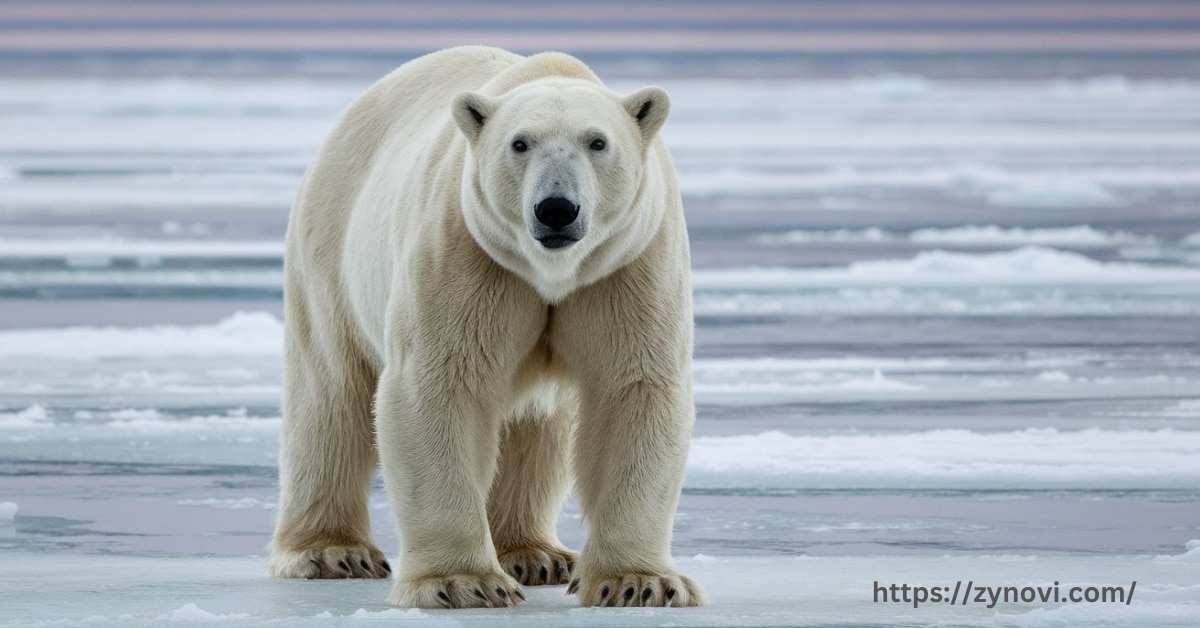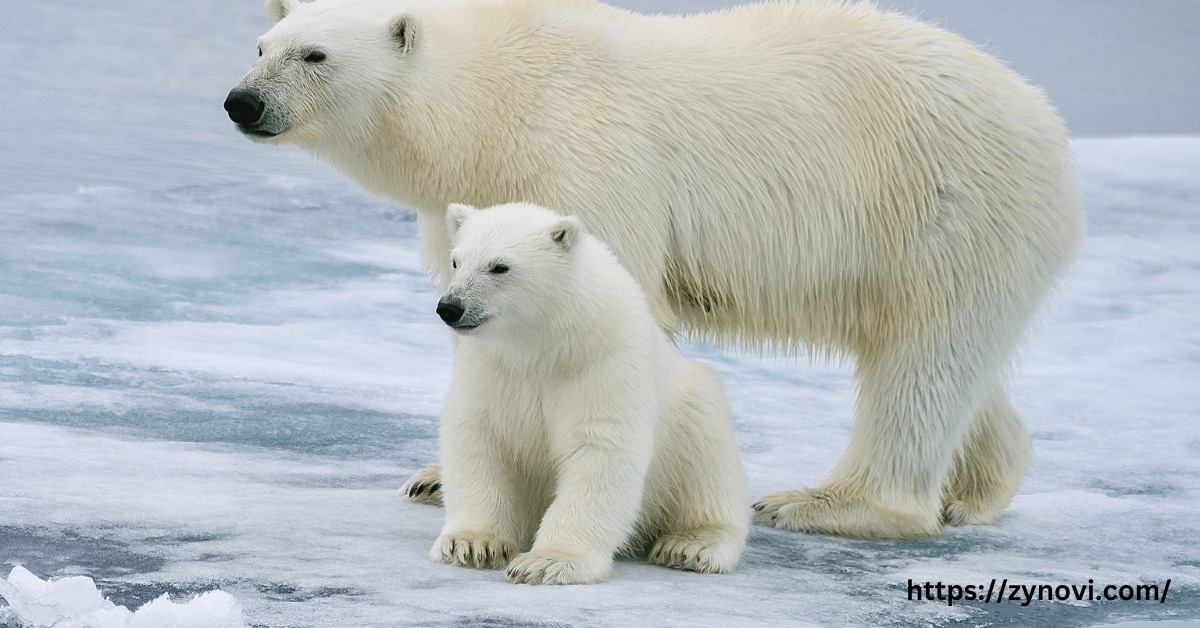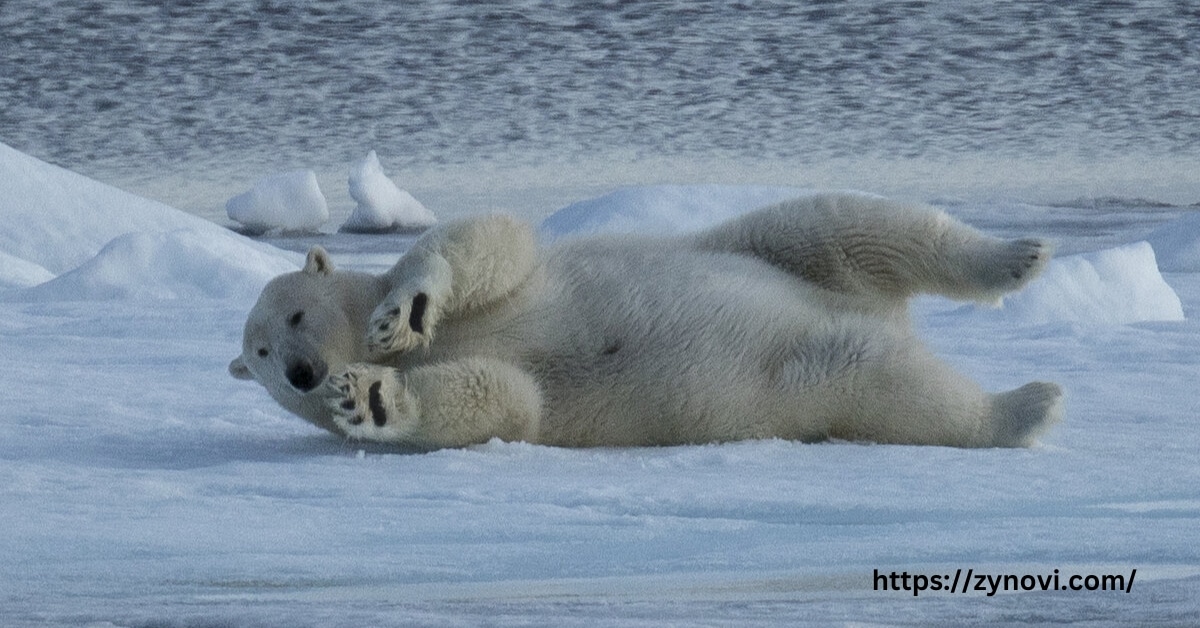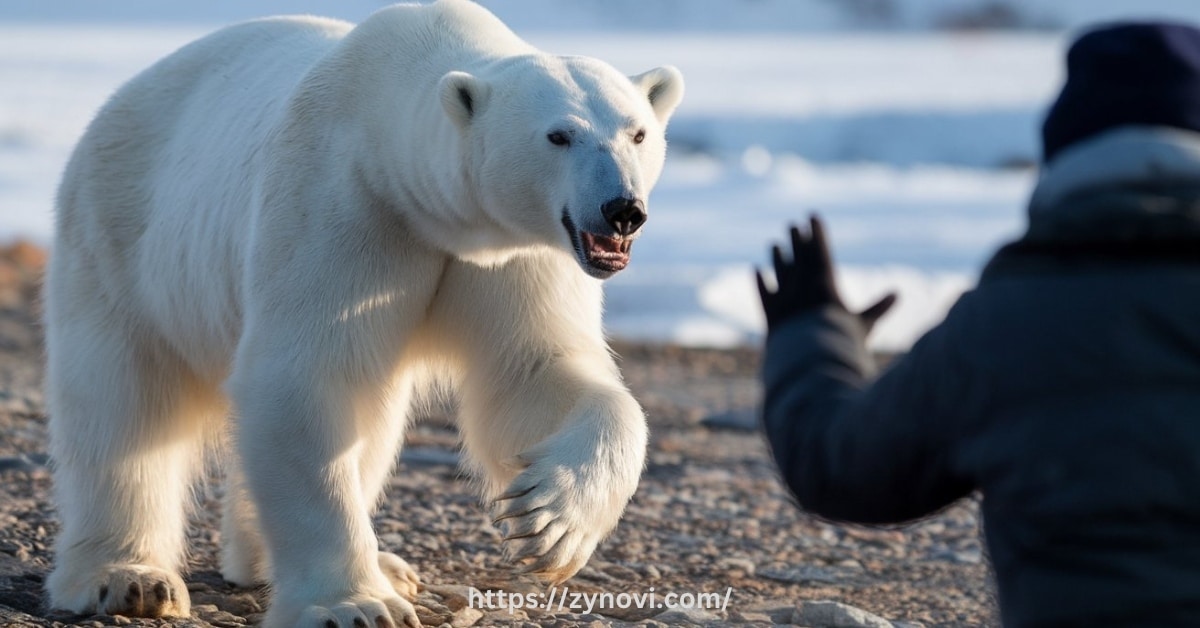Do Polar Bears Attack Humans? Polar bears are awe-inspiring creatures, their interactions with humans can be unpredictable and dangerous.
This is a question that might send a shiver down your spine, especially if you’re planning an Arctic adventure. Understanding the risks and how to stay safe is crucial for anyone venturing into their icy domain.
But don’t panic just yet. With the right knowledge and precautions, you can dramatically reduce your chances of an encounter. Keep reading to discover the fascinating truths behind polar bear behavior, and learn exactly what to do if you ever find yourself in a potentially life-threatening situation.
Understanding Polar Bears
Polar Bear Overview
Polar bears are apex predators of the Arctic Circle, found primarily along the Arctic Ocean and surrounding regions like Nunavut, Canada, and the Svalbard Archipelago, Norway. They are uniquely adapted to their icy environment:
| Characteristic | Description |
|---|---|
| Size | Males: Up to 1,500 lbs; Females: ~600 lbs |
| Height | Up to 10 feet when standing on hind legs |
| Lifespan | 20–30 years in the wild |
| Diet | Carnivorous; primarily seals |
| Habitat Range | Arctic Circle, ice floes, and coastal areas |
Interesting Fact: Polar bears’ fur appears white but is actually transparent, reflecting visible light to blend into the snow.
Polar Bear Diet and Predatory Behavior
Polar bears rely heavily on seals as their primary food source, particularly ringed and bearded seals. They employ a hunting strategy known as “still-hunting,” where they wait patiently near seal breathing holes in the ice, striking when a seal surfaces for air.
Ice floes serve as vital platforms for their ambushes, enabling them to conserve energy while stalking prey. However, the melting Arctic ice, driven by climate change, has disrupted these hunting patterns.
This environmental challenge forces polar bears to expend more energy and travel greater distances in search of food. In extreme cases, food scarcity pushes them into human settlements, increasing the likelihood of conflict as they scavenge for sustenance.
Do Polar Bears Attack Humans?

Why Polar Bears Attack Humans?
While rare, How aggressive are polar bears? do occur under specific conditions:
- Hunger: Polar bears facing declining seal populations often venture closer to human settlements, driven by the need to find alternate food sources.
- Provoked Attacks: Protective mothers may exhibit defensive aggression to safeguard their cubs, especially if they perceive humans as a threat.
- Curiosity: Naturally inquisitive, polar bears might investigate unfamiliar scents, sounds, or movements, which can lead to unintended encounters with humans.
- Environmental Stress: Changes in the Arctic ecosystem, such as reduced ice coverage and food scarcity, push polar bears into overlapping territories with humans, increasing the chances of conflict.
Documented Cases of Polar Bear Attacks
Several high-profile incidents highlight the dangers of polar bear encounters:
- 2011 Svalbard Incident: A polar bear attacked a British school expedition, resulting in one fatality and injuries.
- 2018 Nunavut Attack: A hunter in Nunavut, Canada, was killed by a polar bear while protecting his camp.
- 2013 Churchill Incident: Known as the “Polar Bear Capital,” Churchill, Manitoba, saw increased bear activity near its community.
How Common Are Polar Bears Attack Humans?
Polar bear attacks are exceptionally rare due to their remote Arctic habitats, where human presence is minimal. A comprehensive 2009 study identified 73 documented attacks worldwide between 1870 and 2009, of which 20 were fatal.
Despite their infrequency, instances are gradually increasing as climate change and food scarcity drive polar bears closer to human-populated areas.
These environmental pressures force bears to explore new territories, heightening the risk of human-wildlife conflict.
Situations Likely to Trigger Attacks
- Surprise Encounters: Polar bears startled at close range may react aggressively to perceived threats.
- Intrusion: Entering dens or active hunting grounds often provokes defensive responses from protective bears.
- Food Attractants: Improperly stored food at campsites can lure bears, creating dangerous situations.
- Unfamiliar Territories: Environmental shifts push bears into areas outside their natural range, increasing potential human interactions.
Are Polar Bear Attacks Deadly?

Severity of Injuries and Survival Rates
Polar bear attacks often result in serious injuries or fatalities due to their immense strength and sharp claws. Survivors report:
- Bluff Charges: These are warning maneuvers where a bear charges but stops short, attempting to intimidate without engaging.
- Committed Attacks: Direct and forceful strikes intended to incapacitate prey, often resulting in severe injuries.
Quick Stat: Polar bears can deliver blows powerful enough to crush a seal’s skull in one strike.
Comparing Polar Bear Attacks to Other Bears
| Bear Species | Average Attack Severity | Frequency |
|---|---|---|
| Polar Bear | High | Rare |
| Grizzly Bear | Moderate | More Common |
| Black Bear | Low | Least Common |
How to Avoid Polar Bear Encounters
Here are the preventive measures for Arctic travelers, expanded with more detail:
- Travel in Groups: Bears are less likely to approach larger groups, as they often perceive humans as a threat. Traveling in a group also increases your chances of deterring an encounter with a bear through collective action and noise.
- Stay Vigilant: Continuously scan your surroundings, especially in areas with limited visibility. Bears are often more active during dawn and dusk, so heightened awareness during these times is crucial.
- Proper Food Storage: Use bear-proof containers to securely store food and toiletries. These containers are designed to prevent bears from accessing your supplies, reducing the risk of attracting them with food odors.
- Avoid Known Bear Areas: Before heading out, check local advisories and bear activity reports. Some areas are known bear habitats, especially during mating or feeding seasons, and staying away from these zones minimizes the risk of encounters.
Tools and Strategies for Safety
Here are the tools and strategies for polar bear aggression in Arctic traveler safety, with more detailed explanations:
- Bear Spray Deterrent: Bear spray is a highly effective deterrent when used correctly, creating a powerful cloud of irritant that can stop a bear in its tracks. However, its effectiveness can be reduced by strong winds.
- Electric Fencing: Setting up electric fences around campsites is an ideal strategy for protecting food and shelter in remote Arctic areas. These fences create a barrier that deters bears from entering, offering peace of mind while you sleep or cook.
- Noise Makers: Noise makers such as air horns or flares can effectively alert bears to human presence and scare them off. The loud sound disrupts the bear’s natural behavior, encouraging it to retreat rather than investigate further.
What to Do if a Polar Bears Attack in Humans?

Are polar bears aggressive towards humans? Here are the steps to follow in case of with added details:
Immediate Actions to Survive
- Stay Calm: Panic can cloud your judgment and worsen the situation. Remaining calm allows you to think clearly and make better decisions for your safety. Take slow, deliberate breaths to control your nerves.
- Back Away Slowly: Never turn your back on a polar bear or run, as it may trigger a chase response. Slowly back away while keeping eye contact to show you’re aware of its presence, but don’t make sudden movements that could provoke it.
- Raise Arms: To make yourself appear larger and more intimidating, raise your arms or hold an object overhead. This may help the bear see you as a threat, encouraging it to avoid you.
- Make Loud Noises: Shout, use a whistle, or activate an air horn to create noise that could startle the bear. Polar bears may be deterred by loud, unexpected sounds, as it signals danger or a threat.
Handling Post-Attack Situations
- Seek Immediate Medical Attention: If injured, prioritize getting medical help immediately, as polar bear attacks can cause severe wounds. Even minor injuries can lead to infections or complications, so professional care is crucial.
- Report the Incident: Notify local authorities or wildlife management organizations about the attack. This helps track bear activity and prevent future incidents, ensuring appropriate measures are taken to protect others in the area.
FAQs
What should you do if you spot a polar bear nearby?
Remain calm, avoid sudden movements, and back away slowly. Seek shelter or climb to a higher ground if possible.
Are polar bears attack increasing due to climate change?
Yes, climate change impacts like melting ice reduce hunting grounds, pushing polar bears into human territories.
Can polar bears be deterred with bear spray or deterrents?
Bear spray can work if applied correctly, but its effectiveness depends on proximity and wind direction.
Do polar bears see humans as prey?
Polar bears typically view humans as threats, not prey, but food scarcity can alter this behavior.
What warning signs do polar bears give before attacking?
Look for signs like bluff charges, vocalizations, or a direct, unwavering approach.
Conclusion: Do Polar Bears Attack Humans?
While polar bear attacks are rare, their severity underscores the need for vigilance and preparation when traveling in the Arctic. Understanding polar bear behavior, practicing safety measures, and respecting their natural habitat are essential to reduce human-bear conflicts.
As the Arctic ecosystem evolves under the strain of climate change, coexistence strategies will play a pivotal role in ensuring safety for both humans and these magnificent predators.
“Respect the wild, prepare for the unexpected, and safeguard the balance between humans and nature.”










